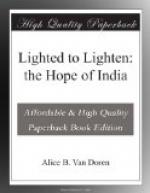Some of the Christian girls come from origins as crude as that of Arul. To such the simplest elements of hygiene are unknown, and cleanly and decent living is the first and hardest lesson to be learned. Others are orphans, waifs, and strays cast up from the currents of village life. Uncared for, undernourished, with memories of a tragic childhood behind them, it is sometimes an impossible task to turn these little, old women back into normal children. But the largest number are children of teachers and catechists, pastors, and even college professors, who come from middle class homes, with a greater or less collection of Christian habits and ideals. With all these is a small scattering of high caste Hindu girls, the children of exceptionally liberal parents. The resulting school community is a wonderful example of pure democracy. Ignorant village girls learn more from the “public opinion” of their better trained schoolmates than from any amount of formal discipline; while daughters of educated families share their inheritance and come to realize a little of the need of India’s illiterate masses. So school life becomes an experiment in Christian democracy, where a girl counts only for what she can do and be; where each member contributes something to the life of the group and receives something from it.
What the Girls Study.
Schools are schools the world over, and the agonies of the three R’s are common to children in whatever tongue they learn. An Indian kindergarten is not so different from an American, except for language and local color. Equipment is far simpler and less expensive, but there is the same spontaneity, the same joy of living; laughter and play have the same sound in Tamil as in English. Besides, Indian kindergartens produce some charming materials all their own—shiny black tamarind seeds, piles of colored rice, and palm leaves that braid into baby rattles and fans.
So, too, a high school course is much the same even in India. The right-angled triangle still has an hypotenuse, and quadratics do not simplify with distance, while Tamil classics throw Vergil and Cicero into the shade. The fact that high school work is all carried on in English is the biggest stumbling block in the Indian schoolgirl’s road to learning. What would the American girl think of going through a history recitation in Russian, writing chemistry equations in French, or demonstrating a geometry proposition in Spanish? Some day Indian education may be conducted in its own vernaculars; to-day there are neither the necessary text-books, nor the vocabulary to express scientific thought. As yet, and probably for many years to come, the English language is the key that unlocks the House of Learning to the schoolgirl. Indian classics she has and they are well worth knowing; but even Shakespeare and Milton would hardly console the American girl for the loss of all her story books, from “Little Women” and “Pollyanna” up—or down—to the modern novel. To understand English sufficiently to write and speak and even think in it is the big job of the High School. It is only the picked few who attain unto it; those few are possessed of brains and perseverance enough to become the leaders of the next generation.




